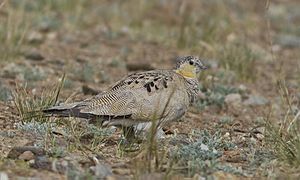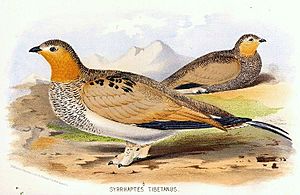Tibetan sandgrouse facts for kids
Quick facts for kids Tibetan sandgrouse |
|
|---|---|
 |
|
| Female Tibetan sandgrouse. Photograph has been taken at Tso Kar, Ladakh, Jammu and Kashmir, India | |
| Conservation status | |
| Scientific classification | |
| Genus: |
Syrrhaptes
|
| Species: |
tibetanus
|
The Tibetan sandgrouse (Syrrhaptes tibetanus) is a large bird that belongs to the sandgrouse family. Its name, Syrrhaptes, comes from an old Greek word meaning "sewn together." This is because its feathered toes are joined. The second part of its name, tibetanus, tells us where it was first found: Tibet.
Contents
What Does the Tibetan Sandgrouse Look Like?
The Tibetan sandgrouse is about 30 to 41 centimeters (12 to 16 inches) long. It has a small head and neck, much like a dove or pigeon. Its body is strong and compact.
Special Features of This Bird
This bird has long, pointed wings and a tail that looks like a pin. Its face is orange, and its chest, neck, and head are grey with fine stripes. It has a white belly and black feathers under its wings.
How Males and Females Are Different
Male Tibetan sandgrouse have plain, buff-colored wings. Females, however, have striped wings and upper bodies. Young birds, called juveniles, do not have the "pin" on their tail. They also have fewer stripes and less orange on their face.
Unique Feet of the Sandgrouse
The Tibetan sandgrouse has small feet with no back toe. Its three front toes are joined together. The top of its foot is covered in feathers, and the bottom has a soft pad. This makes its foot look more like a paw than a bird's foot! These features help it walk on sandy ground.
Where Do Tibetan Sandgrouse Live?
Tibetan sandgrouse live in the mountains of Central Asia, including Tibet, Central China, and the Himalayas. They prefer to live on dry, sandy plains close to water.
How Many Are There?
Even though the number of Tibetan sandgrouse is slowly going down, there are still many of them across a large area. Because of this, the IUCN lists them as a species of "Least Concern." This means they are not currently in danger of disappearing.
How Tibetan Sandgrouse Live
Tibetan sandgrouse like to be in groups, forming loose flocks. They are very active birds.
Flight and Sounds
When they fly, they are very fast and fly in a straight line. You can often hear them making a loud, double "clanging" sound while in the air. Flocks often fly to water holes at dawn (early morning) and dusk (evening) to drink. They are usually noisier in the morning.
Daily Activities
These birds look for food in the morning and afternoon. They search for food on the wavy, semi-desert plains. When they are looking for food, they move very quickly. In the middle of the day, they often rest. They will squat in a small dip in the ground and enjoy the sun. They are usually not very shy, especially when they are resting.
What Do They Eat?
Tibetan sandgrouse mostly eat seeds. They also enjoy grass, buds, and plants called legumes.
Life Cycle and Reproduction
Tibetan sandgrouse lay their eggs from May to June. They choose a nesting spot on dry, stony plateaus and ridges. The nest is usually a simple scrape on the ground.
Nests and Chicks
Females lay three pale brown, oval-shaped eggs. These eggs have patterns that help them blend in with the ground, making them hard to see. The nest is usually out in the open, but sometimes a stone or some grass might offer a little protection.
When the chicks hatch, they can move around very soon after. They stay with the flock. If danger is near, the adult birds will try to distract the threat. The young chicks will crouch down and stay very still, hoping not to be seen.
See also
 In Spanish: Ganga tibetana para niños
In Spanish: Ganga tibetana para niños



